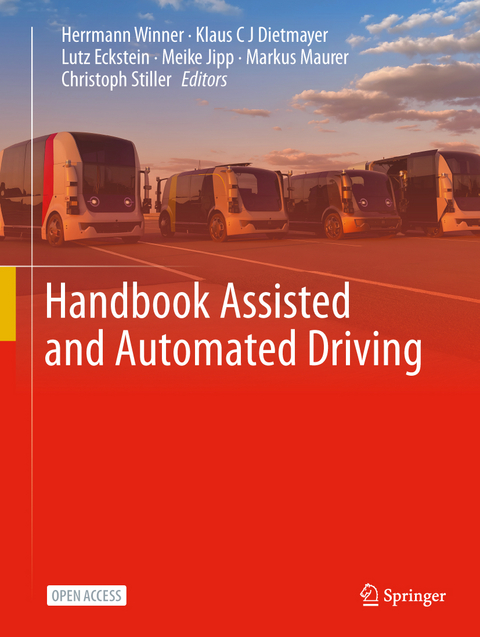
Handbook Assisted and Automated Driving
Springer Fachmedien Wiesbaden GmbH (Verlag)
978-3-658-45275-9 (ISBN)
- Noch nicht erschienen - erscheint am 06.04.2025
- Versandkostenfrei
- Auch auf Rechnung
- Artikel merken
This open access book explains in detail systems and technologies for assisted and automated driving. It also provides an overview of the limitations of such systems concerning development processes and test tools. This description covers today's advanced driver assistance systems with environment perception in passenger cars, commercial vehicles, and motorcycles. This includes functional principles as well as embodiments of the components required for this purpose, such as sensors, actuators, mechatronic subsystems, and actuating elements. Additionally, data fusion concepts, environment representations, and user-friendly designs of the human-machine interface between the assistance system and driver are presented.
New priorities are also presented concerning the development of automated driving. Although automated driving is based on the technology of advanced driver assistance systems, removing humans from the responsibility of driving induces entirely new challenges that also go beyond series technology. The variety of necessary innovative approaches is presented in example applications.
The content
Fundamentals of Advanced Driver Assistance System Development - Virtual Development and Test Environments for ADAS - Test Methods - Sensors for ADAS - Data Fusion and Environment Representation - Digital Infrastructure - Actuation for ADAS - Human-Machine-Interfaces for ADAS - ADAS on Guidance- and Navigation Level - Automated Driving
The target groups
- Automotive development and application engineers
- Students of automotive-electrics, -electronics, -mechatronics
- Students of mechanical engineering/automotive technology
- Students of electronics/ informatics/ information technology
The Editors
Prof. Dr. rer. nat. Hermann Winner headed the Department of Automotive Engineering at the Technical University of Darmstadt (FZD) until 2021.
Prof. Dr.-Ing. Klaus Dietmayer is Director of the Institute of Measurement, Control and Microtechnology at the University of Ulm.
Prof. Dr.-Ing. Lutz Eckstein is Director of the Institute for Automotive Engineering (ika) at RWTH Aachen University.
Prof. Dr. Meike Jipp is Divisional Board Member Energy and Transport, German Aerospace Center (DLR).
Prof. Dr.-Ing. Markus Maurer is Head of the Institute for Control Engineering at the Technical University of Braunschweig.
Prof. Dr.-Ing. Christoph Stiller is Head of the Institute of Measurement and Control Technology (MRT) at the Karlsruhe Institute of Technology.
The editors
Prof. Dr. rer. nat. Hermann Winner headed the Department of Automotive Engineering at the Technical University of Darmstadt (FZD) until 2021.
Prof. Dr.-Ing. Klaus Dietmayer is Director of the Institute of Measurement, Control and Microtechnology at the University of Ulm.
Prof. Dr.-Ing. Lutz Eckstein is Director of the Institute for Automotive Engineering (ika) at RWTH Aachen University.
Prof. Dr. Meike Jipp is Divisional Board Member Energy and Transport, German Aerospace Center (DLR).
Prof. Dr.-Ing. Markus Maurer is Head of the Institute for Control Engineering at the Technical University of Braunschweig.
Prof. Dr.-Ing. Christoph Stiller is Head of the Institute of Measurement and Control Technology (MRT) at the Karlsruhe Institute of Technology.
Part I Fundamentals of Driver Assistance Development.- Human Performance in Vehicle Driving.- Classification of automated driving functions.- The Regulation of Autonomous Driving in California.- Driver Assistance Requirements from Vehicle Regulations and Consumer Protection.- Driver Assistance Systems and Automated Driving Functions - Accident Occurrence and Safety Benefits.- Safety of Assisted and Automated Systems.- Part II Virtual Development and Test Environments for DAS.- Virtual integration.- Dynamic Driving Simulators.- Part III Test methods.- Test procedure for consumer protection and vehicle type approval.- Human-centred assessment methods for assisted driving functions.- Wizard of Oz Vehicles.- EVITA - The procedure for realistic presentation of rear-end collision critical situations in road tests.- Testing with coordinated automated vehicles.- Part IV Sensors for ADAS.- Ultrasonic Sensors.- Automotive Radar.- LiDAR.- Camera Sensors.- Machine Vision.- Stereo Vision for ADAS.- Part V Data Fusion and Environment Representation.- Representation of Fused Environment Data.- SLAM and Map-based Localization.- Part VI Digital Infrastructure.- Digital Maps in Navigation Data Standard Format.- Vehicle-2-X.- Part VII Actuation for ADAS.- Steering Systems for Passenger Cars and Commercial Vehicles.- Electronic Brake Systems.- Part VIII Human-Machine-Interfaces for ADAS.- User-friendly design of human-machine interaction of driver assistance systems.- Control Elements for Driver Assistance Systems.- Occupant State Detection.- Human behaviour as basis for situation und risk assessment.- Part IX ADAS on Guidance- and Navigation Level.- Visibility enhancement systems and signaling devices.- Low Speed Assistance.- Longitudinal Control.- Lateral guidance assistance.- Integrated Longitudinal and Lateral Control.- Motorcycle Riding Assistance Systems.- Driver Assistance Systems in Commercial Vehicles.- Support of Driving Functions by Digital Maps.- Part X Automated Driving.- Human Factors: Level 3+.- Architecture Views for Automated Driving Systems.- Safety and Risk - Why their Definitions Matter.- Tactical Safety for Autonomous Vehicles on Highways.- Decision-Making for Automated Driving.- Optimal Trajectories.- AI for Automated Driving.- Special demands of automated driving on the design process.- Test concepts for the safeguarding of automated driving.- Maintainability and updateability of ADAS Software.- ODD Freight Transportation.- Driverless shuttles as a supplement to local public transport.- ODD Taxi.- Driver state monitoring in automated driving.
| Erscheint lt. Verlag | 6.4.2025 |
|---|---|
| Co-Autor | Tobias Homolla |
| Zusatzinfo | XII, 1145 p. 574 illus., 452 illus. in color. |
| Verlagsort | Wiesbaden |
| Sprache | englisch |
| Maße | 210 x 279 mm |
| Themenwelt | Technik ► Fahrzeugbau / Schiffbau |
| Technik ► Maschinenbau | |
| Schlagworte | ADAS • Assisted Driving • Automated Driving • Autonomous • Lidar • open access • Radar • Software |
| ISBN-10 | 3-658-45275-7 / 3658452757 |
| ISBN-13 | 978-3-658-45275-9 / 9783658452759 |
| Zustand | Neuware |
| Informationen gemäß Produktsicherheitsverordnung (GPSR) | |
| Haben Sie eine Frage zum Produkt? |
aus dem Bereich


